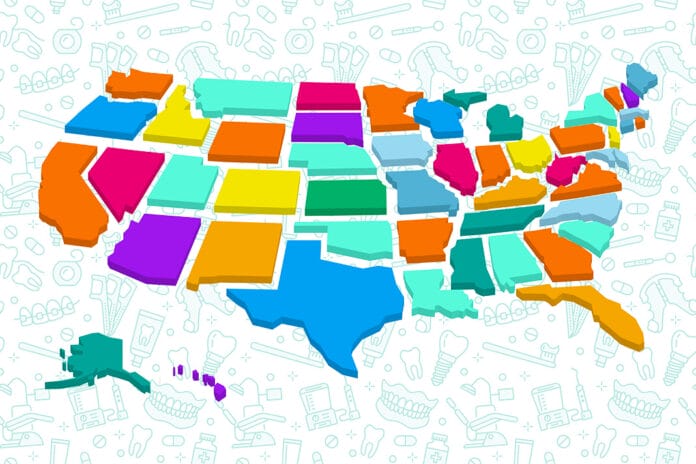Editor’s note: Original publish date: January 18, 2023. Your state’s dental practice act, which can be found on your state’s Board of Dentistry/Board of Dental Examiners website, includes your allowable duties, CE requirements, supervision levels, and the rules pertaining to your state. It is highly encouraged that all dental health care professionals check their state’s dental practice act often, as rules, regulations, and CE requirements can change.
One of the pillars of dental hygiene is the scope of practice. Specifically, our scope of practice can be defined as working “in a host of settings to deliver clinical care and work under varying levels of supervision.”1 On the other hand, not all state’s scopes of practice are the same, and each state has its own laws and regulations on what a dental hygienist can and cannot do.
So what does that really mean?
The practice of dentistry is overseen and regulated by each individual state, not on a national level. The state you are licensed and work in will determine the treatment you can provide, if a dentist must be on site for you to treat patients, and your continuing education course requirements. This also means there are limitations to your treatment and the required supervision. “Scopes of practice have continued to evolve related to advancing technology, new scientific knowledge about disease processes and treatments, and societal demands.”
Supervision Levels
The three main supervision levels are general, direct, and indirect. “General supervision means supervision of dental procedures based on instructions given by a licensed dentist but not requiring the physical presence of a supervising dentist during the performance of those procedures.”3
Direct supervision means a dentist needs to be on the premises while a dental hygienist is performing a specific treatment.3 Indirect supervision is when the dentist approves the procedure or treatment prior, diagnoses the condition that is being addressed with the treatment, and is on the office premises while a dental hygienist is performing the specific treatment.4
Your Neck of the Woods
Some examples of procedures that have been added to some hygienists’ scope in the United States are the administration of local anesthesia, owning their own practices, sedation, nitrous oxide administration, applying silver diamide fluoride, soft tissue fillers, lasers, or the ability to prescribe.
Not all states’ scopes of practice for dental hygienists are the same. As a practicing dental hygienist, you may even realize what you are doing in your state is not legal in another state. For example, in Massachusetts, administering local anesthesia is under direct supervision (the dentist needs to be on the premises).5 In contrast, Oregon hygienists can administer local anesthesia without a dentist on the premises, under general supervision.15
Each state’s scope of practice can be found on their state’s board of dentistry website in the dental practice act.
The scope of practice not only involves different procedures, but it can also include dental hygiene diagnosing and dental hygiene treatment planning. According to the American Dental Hygienists’ Association (ADHA) in 2020 and Arizona Dental Hygienists’ Association President, Jeanette Lalli, Colorado (without supervision), Connecticut (under general supervision), and Oregon (without supervision) are the first “to specifically authorize the dental hygiene diagnosis as part of the dental hygienists’ scope of practice.”7,8
In addition, dental hygiene treatment planning without the supervision of a dentist is allowed in Oregon, Colorado, Nevada, Kansas, and California.8 Under general supervision or with a collaborative practice permit, dental hygiene treatment planning is allowed in New York, Minnesota, Iowa, and North Dakota.8
Interestingly, the West Coast is usually quicker in advancing scopes of practice than the East Coast, such as administering local anesthesia. For example, Washington dental hygienists have been able to administer local anesthesia since 1971. On the other hand, Alabama hygienists have been only allowed to administer infiltrations since 2018 under direct supervision if they hold an infiltration anesthesia permit.9-12
Only a few states allow dental hygienists to do a limited amount of minor restorative services, of which some may require additional education, regional board exams, or certifications. For example, a Massachusetts dental hygienist can cement and remove temporary crowns and bridges under general supervision.20 In Washington state, hygienists who have completed expanded function education through their CODA-accredited hygiene program can perform restorative functions such as “place restorations into the cavity prepared by the dentist, and thereafter could carve, contour, and adjust contacts and occlusion of the restoration.”14
Regardless of where you work, it is recommended to directly read and understand your state’s rules and laws on your scope of practice. Many states have specific rules and details that are required for certain dental treatments.
Continuing Education Requirements
Some requirements may include taking a certain number of continuing education courses, completing clinical hours, taking a board exam, or getting certified. It is important to know the number of continuing education (CE) credits that your state requires per licensure renewal cycle. This includes the breakdown of allowed “live,” “hands-on,” and “self-study” CE credits your state requires or allows.
Due to the COVID-19 pandemic, the term “live” CE course has evolved. Live courses may mean in-person or live webinars (not pre-recorded). Self-study courses are when you complete a course at your own pace and most likely must successfully pass a quiz or assessment at the completion of the course. Keep in mind your state may not allow you to take all your credits under the “self-study” category or gain CE credit by visiting a dental conference’s exhibit hall; there may be limitations.
For example, in my state of Massachusetts, of the total 20 required credits (within a two-year renewal cycle), 10 CE credits can be “self-study,” but only four CE credits can be gained from general attendance at a dental conference.15
In addition, there may be requirements based on your work environment, such as an educational or public health setting. For example, if you are a radiology educator, you may be required to take a certain amount of CE credits on that topic.
Some states have requirements on specific CE course topics and the number of credits needed for each topic. For example, some states require courses in OSHA/infection control, HIPAA, medical emergencies, human trafficking, pain management/opioids, or cultural competency. Further, some states stipulate certain required courses be board-approved. Your state may have requirements for courses that are considered “training” that is beyond CE course requirements. An example of this is CPR/BLS. Certain states allow CPR/BLS certification to be used toward CE credit, while other states do not. This makes knowing the distinction of what your state requires, whether it be CE courses or training courses, essential.
Not completing the proper number of credits or required CE or training courses can put you and your license at risk because it may lead to a board reprimand. State dental boards do random audits each licensure period, and you may be randomly selected for audit.
If requirements are not followed, this can also lead to ethical and legal issues. For example, if you do not renew your license or have the required CE credits by the renewal deadline and continue to work, you would be illegally treating patients because you would be working without a license. Another legal and ethical issue could be providing specific treatments without being certified or under incorrect supervision.
Not knowing your state requirements and rules and/or not abiding by those requirements or rules may lead to fines, license probation, lawsuits, or loss of license to practice, which can become public information. This public information, found on state dental board websites (licensee lookup), can be accessed by patients, employers, future employers, or temp agencies which can be very problematic when looking for a new job. If you are moving and are working on obtaining licensure in another state, licensee lookups can also be done by other state dental boards. If you have board reprimands on your public record, this may lead to applications for licensure being denied.
Dental Therapists are Coming
Dental therapists have been a hot topic recently in the field as this position gives the practitioner extended responsibilities, including restorative treatments, and fills in the “health gaps” or health/community disparities.16 This would be considered mid-level, but still works under (or overseen by) a dentist.16
Each state can create its own requirements and limitations. More recently, Maine and Oregon have passed dental therapist bills. Alaska, Arizona, Colorado, Connecticut, Idaho, Michigan, Minnesota, New Mexico, Nevada, Vermont, and Washington are the other states with dental therapists authorized to work.16,17
The concept of dental therapy originated with “Alaska Native/American Indian leaders to address chronic dentist shortages in their communities.”16 There are only four dental therapist programs in the United States currently; three in Minnesota and one in Alaska.16 The dental therapy program will need to be verified during the state’s license application process. The first dental therapist in Maine graduated from the Minnesota dental therapy program.
The Model Dental Therapist Rule and Best Practices Guide, also known as the Model Rule, was created by National Partnership for Dental Therapy in January 2022.17 The Model Rule was created as a guide to help state boards, governments, and policymakers to help push approval for dental therapy forward.17
License Portability
As experts in preventive oral health, dental hygienists are prepared and competent in assessments, oral health promotion, patient education, oral disease prevention, and evidence-based disease management.4 Some hygienists possess multiple licenses, so they can practice in different states. The biggest issue many professionals come across is the cost and the complicated process.18 There are many fees and different requirements, such as continuing education requirements, record keeping, and applications to complete.
Each state varies as well, causing more confusion and frustration. Military families and traveling dental professionals have experienced these concerns firsthand. This is where license portability can help. The concept for license portability is having states create state compacts (at least two states coming together in agreement), which would be a legal contract to “help facilitate multistate practice for practitioners, maintain or improve public health and safety, and preserve state authority over professional licensing.”1
This idea would increase access to care as well as more opportunities for professionals to practice.18 At this time, the process is in the first phase, which is drafting model legislation.1 Multiple government and dental and health professional organizations are collaborating on this process.
For more discussion on license portability and dentist-dental hygienist compact, please refer to Is License Portability Coming with the Dentist and Dental Hygienist Compact?19
In Closing
Many states are taking strides forward for their dental hygienists as well as the overall profession. The journal Health Affairs states that “enabling hygienists to provide services within their professional competencies under reasonable supervision requirements may yield improvements over time in the oral health status of the populations served.”4
Increasing dental hygienists’ scope of practice will increase access to care as well as the value of the RDH credential. Dental hygienists are a crucial component of a dental office as well as health care. Yes, health care! I believe we are dental professionals as well as health care professionals. Keep working hard out there and continue to look toward the future of the dental hygiene profession!
Before you leave, check out the Today’s RDH self-study CE courses. All courses are peer-reviewed and non-sponsored to focus solely on high-quality education. Click here now.
Listen to the Today’s RDH Dental Hygiene Podcast Below:
References
- Versaci, M. (2022, September 8). ADA, Partners Take Steps to Achieve Greater Licensure Portability for Dentists. American Dental Association. https://www.ada.org/publications/ada-news/2022/september/ada-partners-take-steps-to-achieve-greater-licensure-portability-for-dentists
- Langelier, M., Continelli, T., Moore, J., et al. Expanded Scopes of Practice for Dental Hygienists Associated with Improved Oral Health Outcomes for Adults. Health Affairs. 2016; 35(12): 2207-2215. https://www.healthaffairs.org/doi/10.1377/hlthaff.2016.0807
- 234 CMR 2.00: Purpose and Definitions. (2018, April 20). Commonwealth of Massachusetts, Board of Registration in Dentistry. https://www.mass.gov/doc/234-cmr-2-purpose-and-definitions/
- Chapter 20-01-02 Definitions. (2022, July 1). North Dakota Legislative Assembly. https://www.ndlegis.gov/information/acdata/pdf/20-01-02.pdf
- 234 CMR 6.00: Administration of Anesthesia and Sedation. (2011, November 21). Commonwealth of Massachusetts, Board of Registration in Dentistry. https://www.mass.gov/doc/234-cmr-6-administration-of-anesthesia-and-sedation/download
- Oregon Dental Practice Act. (2022, July 1). State of Oregon Board of Dentistry. https://www.oregon.gov/dentistry/Documents/Dental%20Practice%20Act%207.1.22.pdf
- Dental Hygiene Diagnosis. (2015, September). American Dental Hygienists’ Association. https://www.adha.org/resources-docs/7111_Dental_Hygiene_Diagnosis_Position_Paper.pdf
- Lalli, J. (2021, November 1). Letter to President Karen Fann and Speaker Rusty Bowers [Report requesting expansion of the scope of practice for the profession of dental hygiene]. Arizona State Legislature. https://www.azleg.gov/alispdfs/sunrise/2021%20AzDHA%20sunrise.pdf
- Fales, M., Falconer, A., Rodriguez, A., et al. (n.d.). The History of Dental Hygiene in Washington State. Washington Dental Hygienists’ Association. http://wsdha.com/index.php?src=gendocs&ref=History&category=Main
- Public Health Code (Excerpt) [Act 368 of 1978]. (1978). Michigan Legislature. http://www.legislature.mi.gov/(S(1gz01gxczcuzmf5fyeojuqp2))/mileg.aspx?page=getObject&objectName=mcl-333-16611
- Alabama Dental Practice Act, Alabama State Code [Section 34-9-60.1]. (2019, October 24). Board of Dental Examiners of Alabama. https://www.dentalboard.org/wp-content/uploads/2021/08/Dental-Practice-Act-12-2018-revised-10-24-2019-20.pdf
- Requirements for the Practice of Dentistry, Dental Hygiene, and Dental Assisting. (2014, October 10). Commonwealth of Massachusetts, Board of Registration in Dentistry. https://www.mass.gov/doc/234-cmr-5-requirements-for-the-practice-of-dentistry-dental-hygiene-and-dental-assisting/download
- Chapter 446, Florida Statutes [Rule 64B5-16.0061, pg. 114-115]. (2022, December). Florida Board of Dentistry. https://floridasdentistry.gov/Forms/laws-and-rules-dentistry.pdf
- Dental Quality Assurance Commission (2021, December 22). Acts that may be Performed by Licensed Dental Hygienists under Close Supervision [WAC 246-817-560]. Washington State Legislature. https://app.leg.wa.gov/wac/default.aspx?cite=246-817-560
- Continuing Education. (2018, April 20). Commonwealth of Massachusetts, Board of Registration in Dentistry. https://www.mass.gov/doc/234-cmr-8-continuing-education/download
- About Dental Therapy. (n.d.). National Partnership for Dental Therapy. https://www.dentaltherapy.org/about/about-dental-therapy
- Mizzi Angelone, K., Corr, A. (2022, February 2). National Coalition Publishes Model Dental Therapy Rules. The Pew Charitable Trusts. https://www.pewtrusts.org/en/research-and-analysis/articles/2022/02/02/national-coalition-publishes-model-dental-therapy-rules
- Schroeder, K. (2022, May 2). A Workforce Win: Dentist and Dental Hygiene License Portability Is Underway. CareQuest. https://www.carequest.org/about/blog-post/workforce-win-dentist-and-dental-hygiene-license-portability-underway
- Rice, A. (2022, September 13). Is License Portability Coming with the Dentist and Dental Hygienist Compact? Today’s RDH. https://www.todaysrdh.com/is-license-portability-coming-with-the-dentist-and-dental-hygienist-compact/











